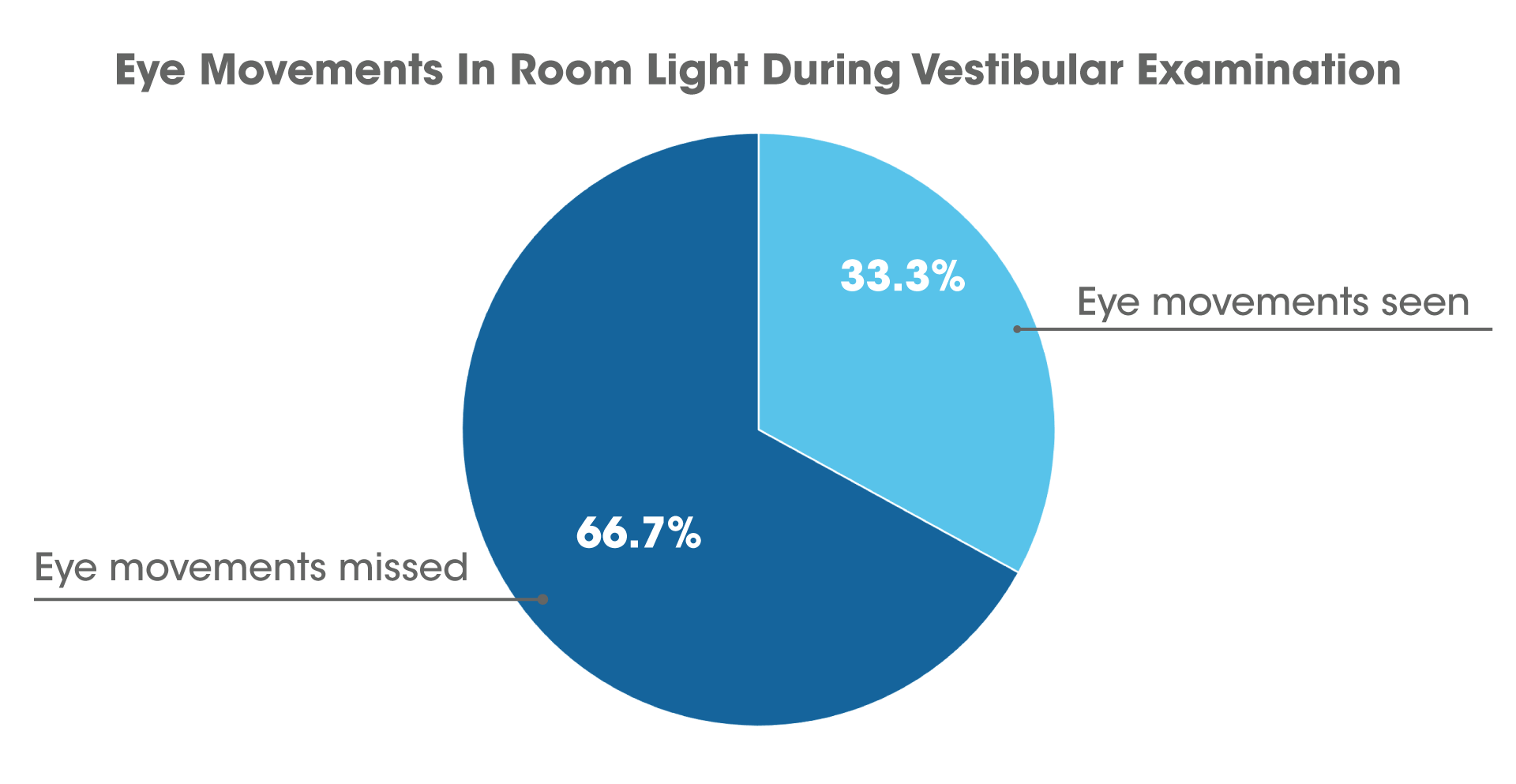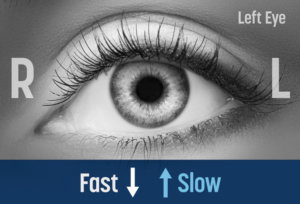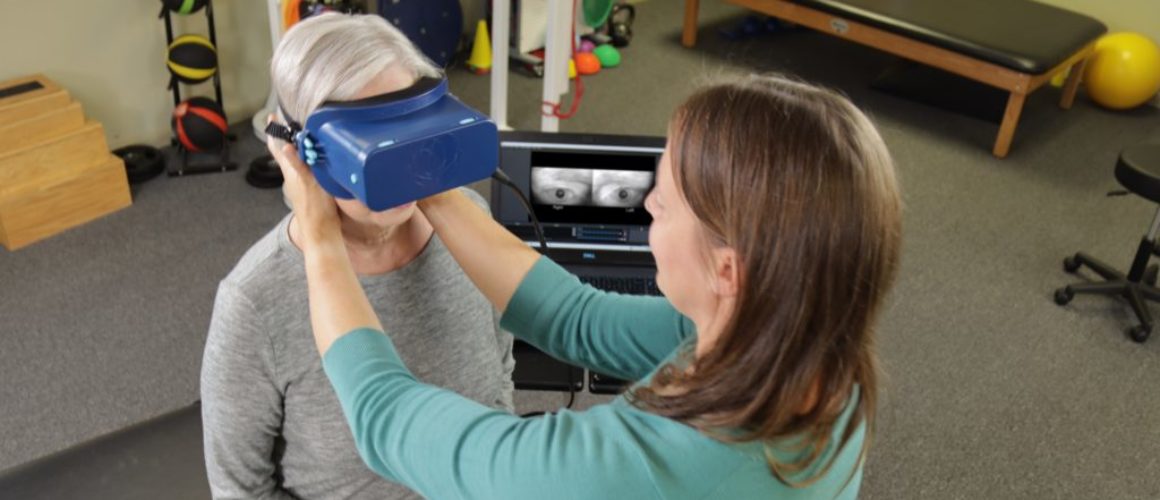Best practices for Healthcare Systems Caring for Patients with Dizziness
The use of infrared video goggles is critical when examining patients with dizziness, vertigo, or imbalance to assist healthcare providers in differentiating peripheral vestibular issues like acute vestibular neuritis or benign paroxysmal positional vertigo (BPPV) from the more serious central vestibular issues such as certain types of stroke.
1. The science behind identifying peripheral and central nystagmus with visual fixation removed via infrared video goggles is strong.
“A fundamental characteristic of peripheral vestibular nystagmus, in particular horizontal nystagmus, is that it is suppressed by visual fixation. This means that a patient with a vertigo attack of peripheral vestibular origin might have no obvious spontaneous nystagmus on clinical examination…Nystagmus goggles are essential for any clinician dealing with dizzy patients.” (Halmagyi et al., 2020).
Research indicates that a clinician is missing about two-thirds of abnormal eye movements in someone with vestibular pathology when they examine a patient only in room light, whereas infrared video goggles and ENG both showed 100% of those same abnormal eye movements (Baba et al., 2004; Ozel et al., 2022). This is true of BPPV, the most common cause of episodic vertigo (Kim et al., 2021). If BPPV goes untreated, patients are at increased risk for falls and fractures (Lawson et al., 2008; Liao et al., 2015).
As a vestibular clinician, we NEED infrared video goggles to help effectively support the diagnosis of:
(1) BPPV;
(2) Peripheral vestibular hypofunction due to neuritis, vestibular schwannoma, autoimmune disease, diabetes, or Meniere’s disease;
(3) Vascular vertigo or vertebrobasilar insufficiency such as Bow Hunter’s syndrome;
(4) Central vestibular dysfunction such as concussion or brain injury, vestibular migraine, multiple sclerosis, cerebellar tumors or strokes, and other brain issues with vestibular signs.

2. Infrared video goggles are critical in helping to identify cerebellar strokes.
Differentiating nystagmus that may indicate a cerebellar stroke is particularly important since brain MRI in the first 24-48 hours after posterior fossa stroke symptom onset may be falsely negative in up to 20% (Newman-Toker et al., 2013; Gurley and Edlow, 2020). Identifying stroke through means beyond imaging is critical since missed cerebellar stroke at the initial ED visit may confer up to an eightfold increased risk of death (Tarnutzer et al., 2011). Imaging alone is not consistently sufficient, since stroke is missed in about 35% of patients presenting with acute dizziness to the ED (Machner et al., 2020).
Nystagmus due to certain types of central vestibular issues is occasionally only visible in darkness (visual fixation removed). In a study working to identify posterior fossa lesions, researchers found that of 13 patients with such lesions, three had “no neurological signs or conventional bedside oculomotor signs; in these cases, vertical nystagmus without fixation was the only sign of a central lesion.” (Bery et al., 2021).
With the help of infrared video goggles and sufficient vestibular exam training, physical therapists have been able to identify strokes mistakenly identified as BPPV, emphasizing the importance of interdisciplinary care (Thomas and Newman-Toker, 2016; Nogi et al., 2022).

3. Infrared video goggles are necessary during Nystagmus portion of the HINTS exam for patients with Acute Vestibular Syndrome (Baron et al., 2021).
The HINTS exam is more sensitive than MRI within 48 hours of cerebellar stroke (Kattah et al., 2009; Edlow et al., 2016). The HINTS exam includes:
-
- Head impulse test – quick impulse of the head both directions, assessing for an acute peripheral vestibular loss due to a condition such as vestibular neuritis;
-
- Nystagmus – examine the patient in room light and then with visual fixation removed, seeking to identify a spontaneous nystagmus.
- Skew – test of skew is an examination of eye alignment which if positive can be indicative of a central vestibular issue such as cerebellar or brainstem stroke.
Conclusion:
The research is clear – it is fundamentally critical to utilize infrared video goggles when examining patients with dizziness in any setting, from the ED to outpatient. Just as a cardiologist requires a stethoscope, vestibular clinicians require infrared video goggles to improve accuracy and efficiency of diagnosis for best practice vestibular care.
References
- Baba S, Fukumoto A, Aoyagi M, Koizumi Y, Ikezono T, Yagi T. (2004). A Comparative Study on the Observation of Spontaneous Nystagmus with Frenzel Glasses and an Infrared CCD Camera. Journal of Nippon Medical School. 71 (1): 25-29.
- Baron R, Steenerson KK, Alyono J. Acute Vestibular Syndrome and ER Presentations of Dizziness. Otolaryngol Clin North Am. 2021 Oct;54(5):925-938.
- Bery AK, Wang CF, Gold DR, Chang TP. The fixation suppression test can uncover vertical nystagmus of central origin in some patients with dizziness. Neurol Sci. 2021 Dec;42(12):5343-5352.
- Edlow JA, Newman-Toker D. Using the Physical Examination to Diagnose Patients with Acute Dizziness and Vertigo. J Emerg Med. 2016 Apr;50(4):617-28.
- Gurley KL, Edlow JA. Diagnosis of Patients with Acute Dizziness. Emerg Med Clin North Am. 2021 Feb;39(1):181-201.
- Halmagyi GM, McGarvie LA, Strupp M. Nystagmus goggles: how to use them, what you find and what it means. Pract Neurol. 2020 Dec;20(6):446-450.
- Kattah JC, Talkad AV, Wang DZ, Hsieh YH, Newman-Toker DE. HINTS to diagnose stroke in the acute vestibular syndrome: three-step bedside oculomotor examination more sensitive than early MRI diffusion-weighted imaging. Stroke. 2009 Nov;40(11):3504-10.
- Kim HJ, Park J, Kim JS. Update on benign paroxysmal positional vertigo. J Neurol. 2021 May;268(5):1995-2000. doi: 10.1007/s00415-020-10314-7. Epub 2020 Nov 24.
- Lawson J, Bamiou DE, Cohen HS, Newton J. Positional vertigo in a Falls Service. Age Ageing. 2008 Sep;37(5):585-9.
- Liao WL, Chang TP, Chen HJ, Kao CH. Benign paroxysmal positional vertigo is associated with an increased risk of fracture: a population-based cohort study. J Orthop Sports Phys Ther. 2015 May;45(5):406-12.
- Machner B, Choi JH, Trillenberg P, Heide W, Helmchen C. Risk of acute brain lesions in dizzy patients presenting to the emergency room: who needs imaging and who does not? J Neurol. 2020 Dec;267(Suppl 1):126-135.
- Newman-Toker DE, Kerber KA, Hsieh YH, Pula JH, Omron R, Saber Tehrani AS, Mantokoudis G, Hanley DF, Zee DS, Kattah JC. HINTS outperforms ABCD2 to screen for stroke in acute continuous vertigo and dizziness. Acad Emerg Med. 2013 Oct;20(10):986-96.
- Nogi A., Ludwig D, Millar J, Carey J, Gold D, Schubert M. The influence of a multidisciplinary decision tree to optimize clinical outcomes in individuals with vestibular pathology. International Vestibular Conference. 2022 Oct; Minneapolis, MN, USA.
- Özel HE, Karakuzu AT, Temir H, Alpay M, Özdoğan F, Genç S. Effect of ocular fixation on positional nystagmus in BPPV patients. Int J Audiol. 2022 Apr 19:1-6.
- Tarnutzer AA, Berkowitz AL, Robinson KA, Hsieh YH, Newman-Toker DE. Does my dizzy patient have a stroke? A systematic review of bedside diagnosis in acute vestibular syndrome. CMAJ. 2011 Jun 14;183(9):E571-92.
- Thomas DB, Newman-Toker DE. Diagnosis is a team sport – partnering with allied health professionals to reduce diagnostic errors. Diagnosis (Berl). 2016 Jun 1;3(2):49-59.

